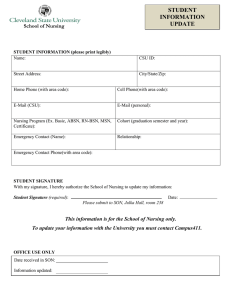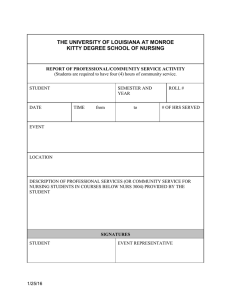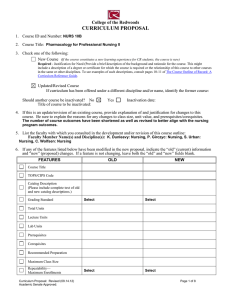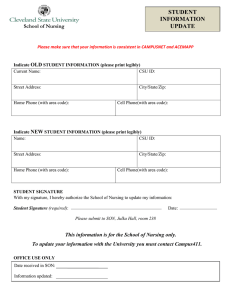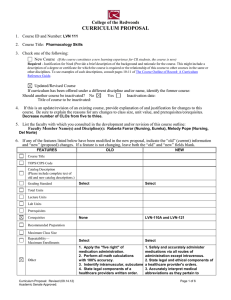CURRICULUM PROPOSAL College of the Redwoods 1. Course ID and Number:
advertisement
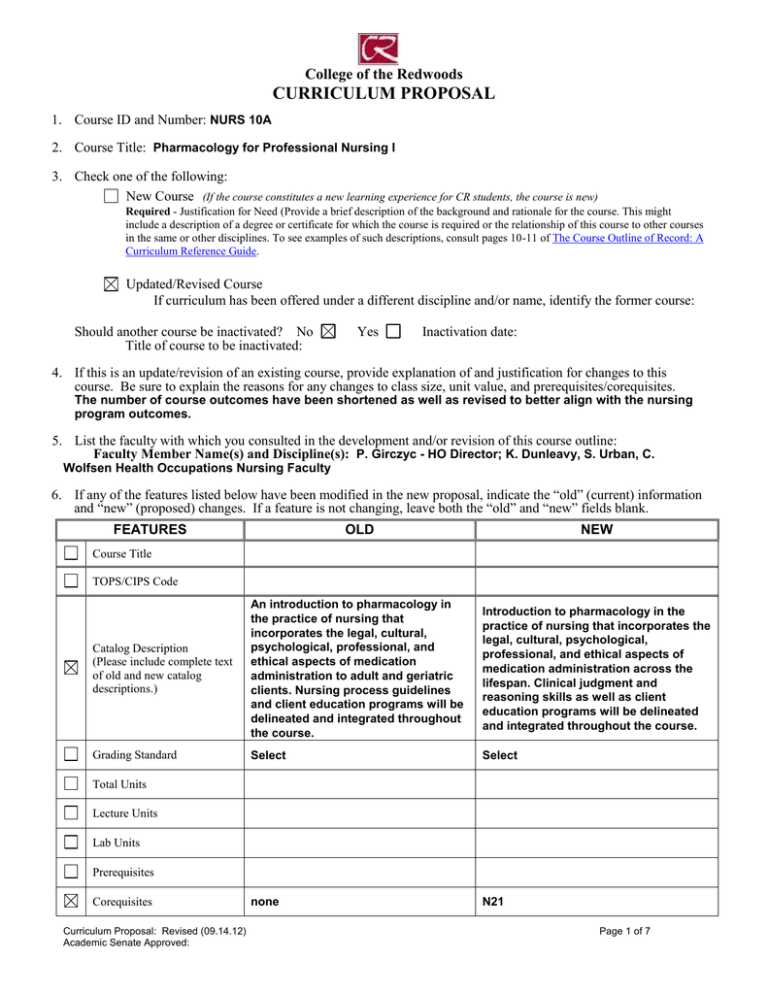
College of the Redwoods CURRICULUM PROPOSAL 1. Course ID and Number: NURS 10A 2. Course Title: Pharmacology for Professional Nursing I 3. Check one of the following: New Course (If the course constitutes a new learning experience for CR students, the course is new) Required - Justification for Need (Provide a brief description of the background and rationale for the course. This might include a description of a degree or certificate for which the course is required or the relationship of this course to other courses in the same or other disciplines. To see examples of such descriptions, consult pages 10-11 of The Course Outline of Record: A Curriculum Reference Guide. Updated/Revised Course If curriculum has been offered under a different discipline and/or name, identify the former course: Should another course be inactivated? No Title of course to be inactivated: Yes Inactivation date: 4. If this is an update/revision of an existing course, provide explanation of and justification for changes to this course. Be sure to explain the reasons for any changes to class size, unit value, and prerequisites/corequisites. The number of course outcomes have been shortened as well as revised to better align with the nursing program outcomes. 5. List the faculty with which you consulted in the development and/or revision of this course outline: Faculty Member Name(s) and Discipline(s): P. Girczyc - HO Director; K. Dunleavy, S. Urban, C. Wolfsen Health Occupations Nursing Faculty 6. If any of the features listed below have been modified in the new proposal, indicate the “old” (current) information and “new” (proposed) changes. If a feature is not changing, leave both the “old” and “new” fields blank. FEATURES OLD NEW Catalog Description (Please include complete text of old and new catalog descriptions.) An introduction to pharmacology in the practice of nursing that incorporates the legal, cultural, psychological, professional, and ethical aspects of medication administration to adult and geriatric clients. Nursing process guidelines and client education programs will be delineated and integrated throughout the course. Introduction to pharmacology in the practice of nursing that incorporates the legal, cultural, psychological, professional, and ethical aspects of medication administration across the lifespan. Clinical judgment and reasoning skills as well as client education programs will be delineated and integrated throughout the course. Grading Standard Select Select none N21 Course Title TOPS/CIPS Code Total Units Lecture Units Lab Units Prerequisites Corequisites Curriculum Proposal: Revised (09.14.12) Academic Senate Approved: Page 1 of 7 Recommended Preparation Maximum Class Size Repeatability— Maximum Enrollments Select Select Other revised SLOs 1. DATE: 05/01/2013 2. DIVISION: Health Occupations 3. COURSE ID AND NUMBER: NURS 10A 4. COURSE TITLE: Pharmacology for Professional Nursing I (Course title appears in Catalog and schedule of classes.) 5. SHORT TITLE: N10A Pharmacology (Short title appears on student transcripts and is limited to 30 characters, including spaces.) 6. LOCAL ID (TOPS): 1230.10 Taxonomy of Program Codes 7. NATIONAL ID (CIP): 51.3801 Classification of Instructional Program Codes 8. DISCIPLINE(S): Nursing Select from Minimum Qualifications for Faculty Course may fit more than one discipline; identify all that apply: 9. FIRST TERM NEW OR REVISED COURSE MAY BE OFFERED: Fall 2013 10. COURSE UNITS: TOTAL UNITS: LECTURE UNITS: 2 2 TOTAL HOURS: 36 LECTURE HOURS: 36 (1 Unit Lecture = 18 Hours; 1 Unit Lab = 54 Hours) LAB UNITS: LAB HOURS: 0 0 11. MAXIMUM CLASS SIZE: 50 12. WILL THIS COURSE HAVE AN INSTRUCTIONAL MATERIALS FEE? No Yes Fee: $ If yes, attach a completed Instructional Materials Fee Request Form found on the Curriculum Website. GRADING STANDARD Letter Grade Only Pass/No Pass Only Is this course a repeatable lab course? No Yes Grade-Pass/No Pass Option If yes, how many total enrollments? Select Is this course to be offered as part of the Honors Program? No Yes If yes, explain how honors sections of the course are different from standard sections. CATALOG DESCRIPTION -- The catalog description should clearly describe for students the scope of the course, its level, and what kinds of student goals the course is designed to fulfill. The catalog description should begin with a sentence fragment. Introduction to pharmacology in the practice of nursing that incorporates the legal, cultural, psychological, professional, and ethical aspects of medication administration across the lifespan. Clinical judgment and reasoning skills as well as client education programs will be delineated and integrated throughout the course. Special Notes or Advisories (e.g. Field Trips Required, Prior Admission to Special Program Required, etc.): Admission to the ADN Program required for enrollment. Appropriate for licensed professionals for update or review with permission of the instructor. Curriculum Proposal: Revised (09.14.12) Academic Senate Approved: Page 2 of 7 PREREQUISITE COURSE(S) No Yes Course(s): Rationale for Prerequisite: Describe representative skills without which the student would be highly unlikely to succeed . COREQUISITE COURSE(S) No Yes Course(s): NURS 21 Rationale for Corequisite: Course content is designed to parallel and complement information presented in NURS 21 and for applcation in the clinical setting. RECOMMENDED PREPARATION No Yes Course(s): Rationale for Recommended Preparation: COURSE LEARNING OUTCOMES –This section answers the question “what will students be able to do as a result of taking this course?” State some of the objectives in terms of specific, measurable student actions (e.g. discuss, identify, describe, analyze, construct, compare, compose, display, report, select, etc.). For a more complete list of outcome verbs please see Public Folders>Curriculum>Help Folder>SLO Language Chart. Each outcome should be numbered. 1. Integrate key principles and elements of pharmacology into nursing practice as they relate to the client, patient care setting and clinical context. 2. Educate the clients on the pharmacological aspects of their medical treatment for successful selfmanagement. 3. List the legal and ethical regulations surrounding medication therapy. COURSE CONTENT–This section describes what the course is “about”-i.e. what it covers and what knowledge students will acquire Concepts: What terms and ideas will students need to understand and be conversant with as they demonstrate course outcomes? Each concept should be numbered. 1. Principles of pharmacology: pharmacodynamics, pharmacokinetics and pharmacotherapeutics for the various drug classifications. 2. Drug therapy across the lifespan. 3. Nursing process and clinical decision making as it relates to all aspects of medication therapy. 4. Patient teaching associated with drug therapy. 5. Professional responsibilities of the RN related to pharmacological safety, legal and ethical issues encountered in the clinical setting. Issues: What primary tensions or problems inherent in the subject matter of the course will students engage? Each issue should be numbered. 1. Pathophysiology of disease states. 2. Pharmacological principles. 3. Drug Classifications and subclassifications. 4. Implications of medication therapy related to age, developmental stage, gender, ethnicity, social/cultural/spiritual practices, educational and or economic level and ability to obtain medications. Themes: What motifs, if any, are threaded throughout the course? Each theme should be numbered. 1. Legal/ethical implications of medication administration. 2. Safety related to medication administration. 3. Client response to drug therapy. 4. Nursing responsiblities and accountability in all aspects of medication administration. 5. Written and verbal communication regarding medication administration and effects. Skills: What abilities must students have in order to demonstrate course outcomes? (E.g. write clearly, use a scientific calculator, read college-level texts, create a field notebook, safely use power tools, etc). Each skill should be numbered. 1. 2. 3. 4. Use medication terminology and abbreviations accurately. Create a concept map for a class of drugs. Create a nursing care plan for a patient taking a particular medication or drug therapy. Research a medication and apply the information to a simulated patient care situation. Curriculum Proposal: Revised (09.14.12) Academic Senate Approved: Page 3 of 7 5. Describe the proper techniques for medication administration. 6. Demonstrate the "eight rights" (safety principles) of medication administration. REPRESENTATIVE LEARNING ACTIVITIES –This section provides examples of things students may do to engage the course content (e.g., listening to lectures, participating in discussions and/or group activities, attending a field trip). These activities should relate directly to the Course Learning Outcomes. Each activity should be numbered. 1. 2. 3. 4. 5. 6. 7. Reading assignments. Listening to condensed lectures via tegrity recordings. Completing student-learning activities online that correspond with the text. Participating in forum style discussions via MyCR. Participating in small group activities electronically. Responding to unfolding medication case scenarios. Writing a paper exploring medications used for pain management based on a hospitalized individual. ASSESSMENT TASKS –This section describes assessments instructors may use to allow students opportunities to provide evidence of achieving the Course Learning Outcomes. Each assessment should be numbered. Representative Assessment Tasks (These are examples of assessments instructors could use.): 1. Quizzes. 2. Midterm and Final Exam (cumulative). 3. Critical Thinking Assignment: Written Paper. Required Assessments for All Sections (These are assessments that are required of all instructors of all sections at all campuses/sites. Not all courses will have required assessments. Do not list here assessments that are listed as representative assessments above.): 1. EXAMPLES OF APPROPRIATE TEXTS OR OTHER READINGS –This section lists example texts, not required texts. Author, Title, and Date Fields are required Author Lilley et al. Author Deglan et al. Author Farrar Title Author Title Title Pharmacology and the Nursing Process Title Davis's Drug Guide for Nurses N10A Course Packet Date Date Date 2011 2013 Updated Annually Date Other Appropriate Readings: RN Pharmacology for Nursing (Assessment Technologies Institute) Health Occupations Nursing Program Handbook - updated each year Fundamentals of Nursing Concepts / Skills Text Medical-Surgical Nursing textbook Drug Calculations text Mosby’s Manual of Diagnostics & Lab Tests Nursing Diagnosis Handbook Tabers Medical Dictionary All textbooks will continue to be updated as new editions are published. COURSE TYPES 1. Is the course part of a Chancellor’s Office approved CR Associate Degree? No Yes If yes, specify all program codes that apply. (Codes can be found in Outlook/Public Folders/All Public Folders/ Curriculum/Degree and Certificate Programs/choose appropriate catalog year): Required course for degree(s) NURS.2012.ASN Restricted elective for degree (s) Restricted electives are courses specifically listed (i.e. by name and number) as optional courses from which students may choose to complete a specific number of units required for an approved degree. 2. Is the course part of a Chancellor’s Office approved CR Certificate of Achievement? Curriculum Proposal: Revised (09.14.12) Academic Senate Approved: No Yes Page 4 of 7 If yes, specify all program codes that apply. ( Codes can be found in Outlook/Public Folders/All Public Folders/ Curriculum/Degree and Certificate Programs/choose appropriate catalog year): Required course for certificate(s) Restricted elective for certificate(s) Restricted electives are courses specifically listed (i.e. by name and number) as optional courses from which students may choose to complete a specific number of units required for an approved certificate. 3. Is the course Stand Alone? No Yes (If “No” is checked for BOTH #1 & #2 above, the course is stand alone.) 4. Basic Skills: NBS Not Basic Skills 5. Work Experience: NWE Not Coop Work Experience 6. Course eligible Career Technical Education funding (applies to vocational and tech-prep courses only): No 7. Course eligible Economic Workforce Development funding : No Yes (If TOPS code has an asterisk it is indicative that the course is vocational.) 8. Purpose: Y Credit Course Course Classification Status 9. Accounting Method: W Weekly Census Yes 10. Disability Status: N Not a Special Class 11. Course SAM Priority Code: C Clearly Occupational Definitions of SAM Priority Codes COURSE TRANSFERABILITY 1. Current Transferability Status: B Transferable to CSU only 2. Course Prior to Transfer Level: Y Not Applicable Definitions of Course Prior to Transfer Levels CURRENT TRANSFERABILITY STATUS (Check at least one box below): This course is currently transferable to: Neither CSU nor UC CSU as general elective credit CSU as a specific course equivalent (see below) If the course transfers as a specific course equivalent give course number(s)/ title(s) of one or more currently-active, equivalent lower division courses from CSU. 1. Course , Campus 2. Course , Campus UC as general elective credit UC as specific course equivalent If the course transfers as a specific course equivalent give course number(s)/ title(s) of one or more currently-active, equivalent lower division courses from UC. 1. Course , Campus 2. Course , Campus PROPOSED CSU TRANSFERABILITY (Check at least one of the boxes below): No Proposal Remove as General Education Propose as General Elective Credit Propose as a Specific Course Equivalent (see below) If specific course equivalent credit is proposed, give course number(s)/ title(s) of one or more currently-active, equivalent lower division courses from CSU. 1. Course , Campus Curriculum Proposal: Revised (09.14.12) Academic Senate Approved: 2. Course , Campus Page 5 of 7 PROPOSED UC TRANSFERABILITY (Check one of the boxes below): No Proposal Remove as General Education Propose as General Elective Credit OR Specific Course Equivalent (fill in information below) If “General Elective Credit OR Specific Course Equivalent” box above is checked, give course number(s)/ title(s) of one or more currently-active, equivalent lower division courses from UC. 1. Course , Campus 2. Course , Campus CURRENTLY APPROVED GENERAL EDUCATION Check at least one box below): Not currently approved CR CR GE Category: CSU CSU GE Category: IGETC IGETC Category: PROPOSED CR GENERAL EDUCATION (Check at least one box below): No Proposal ____ Approved as CR GE by Curriculum Committee: _____ _ Remove as General Education (DATE) Review to maintain CR GE Status ____ Not Approved New GE Proposal CR GE Outcomes GE learning outcomes in Effective Communication, Critical Thinking, and Global Awareness must be addressed in all general education courses. Effective Communications: Explain how the proposed GE course fulfills at least one of the CR GE outcomes in this category. Critical Thinking: Explain how the proposed GE course fulfills at least one of the CR GE outcomes in this category. Global Awareness: Explain how the proposed GE course fulfills at least one of the CR GE outcomes in this category. GE Criteria for Breadth and Generality GE courses should be broad and general in scope. Typically such courses are introductory-- not advanced or specialized—and the content encompasses a broad spectrum of knowledge within a given field of study. Explain how the proposed GE course fulfills GE criteria for breadth and generality. CR GE Area Designation Course Learning Outcomes and Course Content should provide evidence of appropriate GE Area Designation. Additional rationale for GE Area Designation (optional): Natural Science Social Science Humanities Language and Rationality Writing Oral Communications Analytical Thinking PROPOSED CSU GENERAL EDUCATION BREADTH (CSU GE) (Check at least one box below): No proposal A. Communications and Critical Thinking A1 – Oral Communication A2 – Written Communication A3 – Critical Thinking C. Arts, Literature, Philosophy, and Foreign Language C1 – Arts (Art, Dance, Music, Theater) Curriculum Proposal: Revised (Enter Date) Academic Senate Approved: B. Science and Math B1 – Physical Science B2 – Life Science B3 – Laboratory Activity B4 – Mathematics/Quantitative Reasoning D. Social, Political, and Economic Institutions D0 – Sociology and Criminology Page 6 of 7 C2 – Humanities (Literature, Philosophy, Foreign Language) E. Lifelong Understanding and Self-Development E1 – Lifelong Understanding E2 – Self-Development D1 – Anthropology and Archeology D2 – Economics D3 – Ethnic Studies D5 – Geography D6 – History D7 – Interdisciplinary Social or Behavioral Science D8 – Political Science, Government and Legal Institutions D9 – Psychology Rationale for inclusion in this General Education category: Same as above Proposed Intersegmental General Education Transfer Curriculum (IGETC) (Check at least one box below): No proposal 1A – English Composition 1B – Critical Thinking-English Composition 1C – Oral Communication (CSU requirement only) 2A – Math 3A – Arts 3B – Humanities 4A – Anthropology and Archaeology 4B – Economics 4E – Geography 4F – History 4G – Interdisciplinary, Social & Behavioral Sciences 4H – Political Science, Government & Legal Institutions 4I – Psychology 4J – Sociology & Criminology 5A – Physical Science 5B – Biological Science 6A – Languages Other Than English Rationale for inclusion in this General Education category: Same as Above Submitted By: Roberta Farrar Division Chair/Director: Pat Girczyc Approved by Curriculum Committee: No Academic Senate Approval Date: 05.13.13 Curriculum Proposal: Revised (Enter Date) Academic Senate Approved: Tel. Ext. 4236 Review Date: 05/10/2013 Date: 05/01/2013 CURRICULUM COMMITTEE USE ONLY Yes Date: 05.10.13 Board of Trustees Approval Date: 06.04.13 Page 7 of 7
